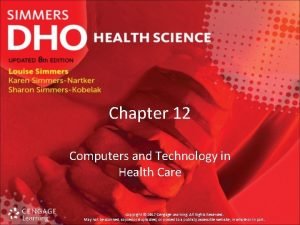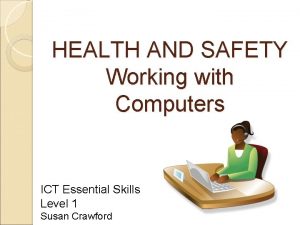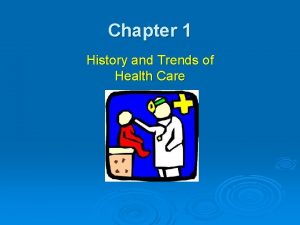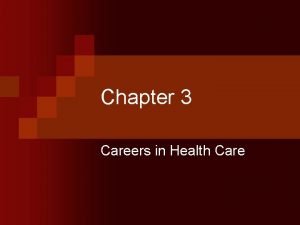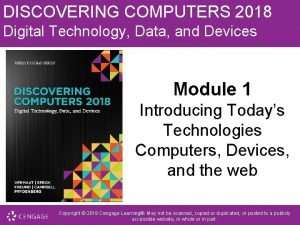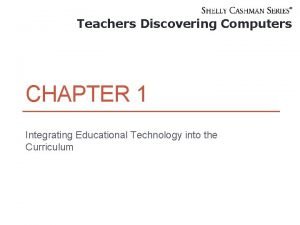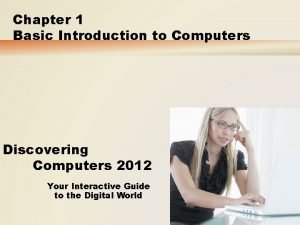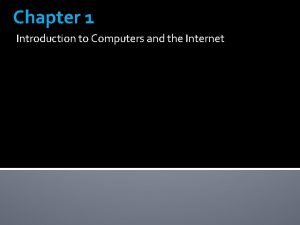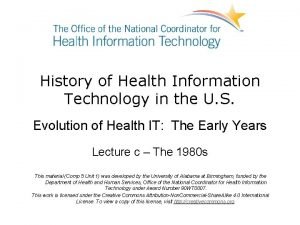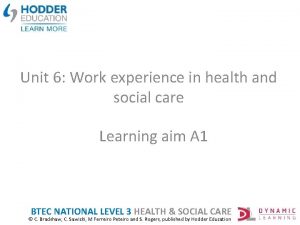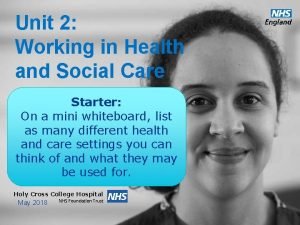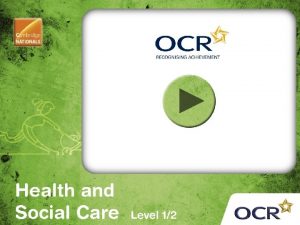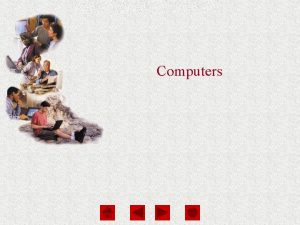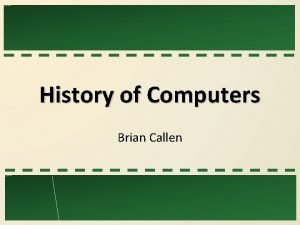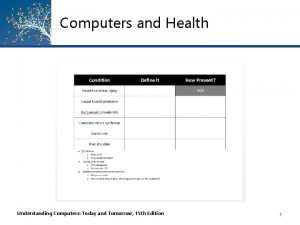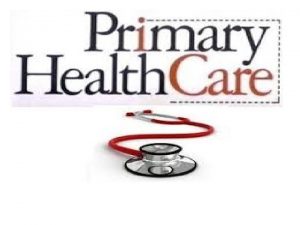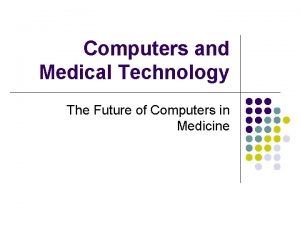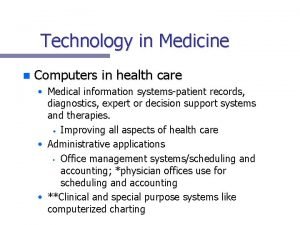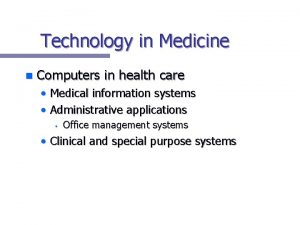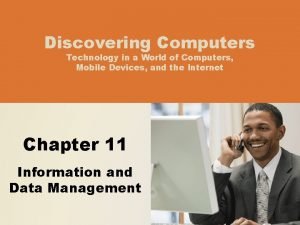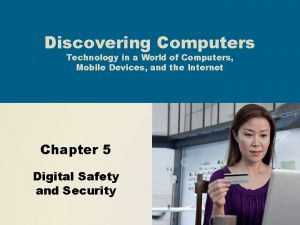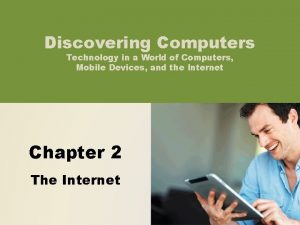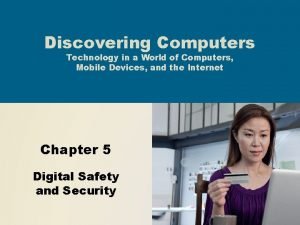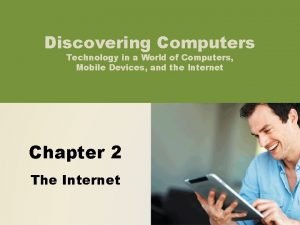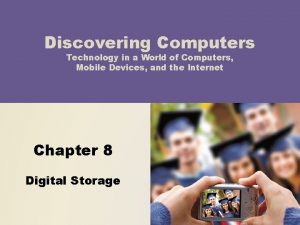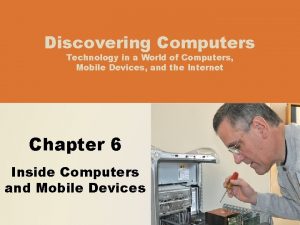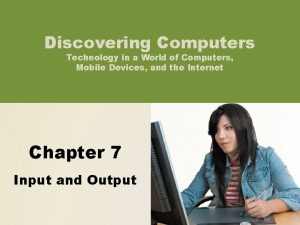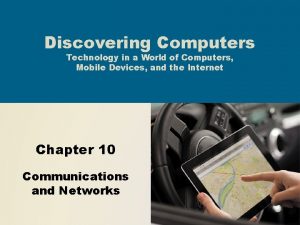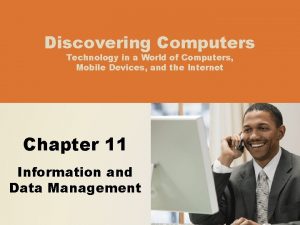Chapter 15 Computers and technology in health care













































- Slides: 45

Chapter 15 Computers and technology in health care By Jahangir Moini, M. D. , M. P. H. and Morvarid Moini, D. M. D. , M. P. H. © 2017 Jahangir Moini

Overview �Health care professionals must understand basics of computers (at least) �Computer security is of vital importance �Inadequate computer security affects: Patients Health care professionals Facilities Society © 2017 Jahangir Moini

Supercomputers �Largest, most complicated type �Extremely fast information processing �Mostly used in research medicine Cancer or DNA research Genetic coding © 2017 Jahangir Moini

Mainframe computers �Mostly used by larger health care institutions: Hospitals Universities Government �Examples: Medicare Medicaid © 2017 Jahangir Moini

Minicomputers �Larger than personal computers Smaller than mainframe computers �Primarily used in networks Linking multiple computers together �Most function as servers Centralized storage locations for shared information © 2017 Jahangir Moini

Personal computers �Also known as microcomputers �Small, self-contained �Perfect for offices, schools, homes �Different designs are based on user needs © 2017 Jahangir Moini

Desktop �Fit on desks and flat surfaces �Most common type used in medical facilities �Many have a tower case: Containing operating components Often placed on floor © 2017 Jahangir Moini

Figure 15 -1: A desktop computer © 2017 Jahangir Moini

Laptop and notebook �Smaller than desktop computers �Weigh only a few pounds �Operate via A. C. power or by battery �Allow easier communication, multiple locations �Mobile, easy to move �Easily exchange electronic health records © 2017 Jahangir Moini

Figure 15 -2: A laptop computer © 2017 Jahangir Moini

Subnotebook and tablet PC �Smaller than laptops �Screens measure 14 inches or less �Subnotebooks being replaced by tablet PCs Offer touchscreens and/or graphics tables Operated with fingers, stylus, digital pen Keyboard or mouse not needed Quickly becoming preferred type of computer © 2017 Jahangir Moini

Figure 15 -3: A tablet PC © 2017 Jahangir Moini

Personal digital assistant (PDA) �Common in health care facilities �Professionals can easily look up reference information and medications �Users easily enter data into patient charts Most popular personal computer for many health care professionals © 2017 Jahangir Moini

Computers in health care �All health care departments utilize computerization �High-speed communication occurs via computer networks: Electronic record systems Processing of monitoring device information Word processing of medical information Scheduling Electronic prescribing, prescription processing Medical coding Supply inventories, billing Medical test processing © 2017 Jahangir Moini

Benefits of computer use in health care systems Benefit Comments Improved quality of care Order entry, data handling, billing, documentation, monitoring, dispensing, testing, imaging, alerting, reporting Decreased costs Linking to electronic records, reducing work times, improving communication, organizing schedules Uniformity Integration of health care systems, referencing, databases, updating, use of terminology Patient knowledge Involving patients in care, offering visual images, education, answering questions Internet capability Telemedicine, telepharmacy, use of sensory and input devices in emergencies Patient accessibility Social networking, daily health monitoring, patient–provider interactions © 2017 Jahangir Moini

Information technology �Larger facilities usually have information technology (IT) departments These oversee computer systems � Employees do not perform as many computer tasks as those in smaller facilities © 2017 Jahangir Moini

Patient monitoring �Computers are commonly used to monitor: Heart rate Respiration �Offer alarm systems Alert health care professionals to problems �Movable terminals Allow entering of all needed patient information © 2017 Jahangir Moini

Patient monitoring �Point-of-care charting systems: Information entered at the patient’s bedside Can track vital signs, physical status, other factors Can be linked to central locations: � Such as nursing stations (constantly monitored) © 2017 Jahangir Moini

Patient monitoring �Laptops used for: Monitoring Mobility Recordkeeping Information exchange Charting �Used in home health care (telemonitoring) Utilizes patient interaction Displays reminders for taking medications Wireless monitoring on devices connected to Internet, phone lines © 2017 Jahangir Moini

Figure 15 -4: Physician using a laptop computer in a home care setting © 2017 Jahangir Moini

Information management �Database Uses software that makes information searchable Record � Each group of related data Such as an individual patient record � User types data into predefined fields Name, phone number, address, occupation, insurer File �A group of related fields © 2017 Jahangir Moini

Information management �Records searched by: Last name Insurers Addresses Dates �More than one person has access simultaneously �Changes are easily made �Quality improvement studies can be performed �Data entry must be accurate to avoid lawsuits © 2017 Jahangir Moini

Computerization of medical records �Electronic medical records (EMRs): Most common forms of patient information �Better efficiency, lower costs, safer care �Health care facilities Now required to use computerized record keeping © 2017 Jahangir Moini

Computerization of medical records �EMRs are shareable, usable by all types of facilities: Patient I. D. information Emergency department visits Preventive care Clinic and inpatient notes Lab, pharmacy, and radiology data Surgical procedures Billing information © 2017 Jahangir Moini

Spreadsheets �Spreadsheet software programs: numerical data Rows and columns with individual blocks (cells) Calculation formulas inserted for billing, accounting � Changes and recalculations are easy and quick to perform Easily linked to electronic billing programs Allow for creation of charts and graphs © 2017 Jahangir Moini

Diagnostics �Expert systems �Fiber optics �Patient questionnaires �Diagnostic imaging: Images mathematically converted into measurements Better viewing of soft tissues More detailed, clearer than X-rays Digital X-rays also available (less radiation) © 2017 Jahangir Moini

Diagnostics �Other diagnostic technologies include: Computerized tomography (CT) Magnetic resonance imaging (MRI) Positron emission tomography (PET) Ultrasound © 2017 Jahangir Moini

Figure 15 -5 A: Computed tomography (CT) machine © 2017 Jahangir Moini

Figure 15 -5 B: Ultrasound (ultrasonography) © 2017 Jahangir Moini

Diagnostics �CT X-rays taken from many angles Tissue density measurements Converted to cross-sections �MRI Magnetic field measures hydrogen atom activity Converted to cross-sections © 2017 Jahangir Moini

Diagnostics �PET Radioactive substance is injected, scanned Converted to three-dimensional images �Ultrasonography High-frequency sound waves create echoes of body structures Captured signals are used to create images © 2017 Jahangir Moini

Diagnostics �Electrical impedance tomography (EIT) Newer, experimental technology Uses skin electrodes � Allow electrical currents to be measured � Detects tissue differences © 2017 Jahangir Moini

Expert systems �Help diagnose, treat conditions via artificial intelligence Computer performs tasks usually needing human intelligence: � Visual perception � Decision-making � Speech recognition � Language translation Assist in decisions, not replacing human interaction �Examples: � ATHENA � GIDEON � CEMS � Therapy. Edge HIV © 2017 Jahangir Moini

Fiber optics �Organ or cavity viewed via plastic fibers that transmit light through a special tube This reflects a magnified image Examples include fiberoptic: � Colonoscopes � Duodenoscopes � Bronchoscopes © 2017 Jahangir Moini

Fiber optics �Tiny cables, thin as human hairs, that transmit data �Has greatly increased safety for many surgical procedures Tiny cameras are inserted through narrow tubes Only tiny incisions and instruments are needed Often used for: � Repair of hip fractures � Spinal fusions © 2017 Jahangir Moini

Patient questionnaires �Computer terminals allow them to enter information into electronic forms Answers help identify risk factors, perform health screening �Health calculators aid in determining: Target heart rates Body mass index Energy expenditure Other information © 2017 Jahangir Moini

Treatment �Robotic surgery Allows use of minimally invasive procedures with more accuracy Specially trained surgeon guides robot Interacts with 3 -D cameras, voice commands Often used for: � Head and neck cancers � Gynecological cancer � Cardiac surgery � Prostate cancer © 2017 Jahangir Moini

Treatment �Laser surgery Finely focused light rays used Corrective eye surgery �Image-guided surgery CT is combined with infrared technology Uses invisible radiant energy for 3 -D accuracy �Computer modeling used in: Dentistry Reconstructive surgery Cosmetic surgery © 2017 Jahangir Moini

Research �Detailed searches for very precise data �Electronic research Much faster, accurate than traditional research with printed materials �Bioinformatics Used in the Human Genome Project � Organization of biological data into electronic databases © 2017 Jahangir Moini

Research �Gene therapy Uses normal genes inserted into cells These replace abnormal genes linked to disease �Drug therapy has also benefitted by Computerized research � New drugs developed more quickly than ever before © 2017 Jahangir Moini

Telemedicine �Uses telecommunication equipment, information technology �Provides clinical care to individuals at distant sites �Transmits information, images Allows examinations, monitoring, testing �All types of professionals, patients linked: Emergency caregivers Physicians Home-bound Specialists © 2017 Jahangir Moini

Telemedicine �Legal challenges about practice location regulations exist Telemedicine has been performed successfully on a global basis �Robotic systems have been integrated �Offers assistance to people who lack access to the latest imaging equipment © 2017 Jahangir Moini

Telepharmacy �Delivery of pharmaceutical care Via use of telecommunications equipment �Drugs dispensed at locations other than pharmacies �Prescriptions sent to computerized dispensing units �Video conferencing, patient counseling possible © 2017 Jahangir Moini

Computer security �Passwords are unique to every user �No sharing of passwords �Do not leave workstations unattended �Close all open programs before leaving �Keep unauthorized individuals from viewing information �Computer printouts shredded before discarding �Regular back-ups of files © 2017 Jahangir Moini

Computer security �Computer viruses Destructive programs that attempt to access information illegally Usually spread from programs downloaded via Internet � Or from infected files loaded into computer �At work, Internet usage should only involve work- related tasks Do not “surf” Internet for personal reasons © 2017 Jahangir Moini
 Test chapter 12 computers and technology in health care
Test chapter 12 computers and technology in health care Health and social component 3
Health and social component 3 Health and social care values unit 2
Health and social care values unit 2 Primary secondary and tertiary health care
Primary secondary and tertiary health care Health and safety on computers
Health and safety on computers Appropriate technology in primary health care
Appropriate technology in primary health care Chapter one history and trends of health care
Chapter one history and trends of health care Chapter 1 history and trends of healthcare
Chapter 1 history and trends of healthcare Chapter 13 diversity and difference in health care
Chapter 13 diversity and difference in health care Computer programming chapter 1
Computer programming chapter 1 Chapter 1 introduction to computers and programming
Chapter 1 introduction to computers and programming Chapter 1 introduction to computers and programming
Chapter 1 introduction to computers and programming Chapter 1 introduction to computers and programming
Chapter 1 introduction to computers and programming Chapter 3 health wellness and health disparities
Chapter 3 health wellness and health disparities Chapter 1 lesson 2 what affects your health
Chapter 1 lesson 2 what affects your health Glencoe health chapter 1 understanding health and wellness
Glencoe health chapter 1 understanding health and wellness Chapter 3 careers in health care
Chapter 3 careers in health care Chapter 3 careers in health care
Chapter 3 careers in health care Chapter 2 health care systems
Chapter 2 health care systems Chapter 1 introduction to health care agencies
Chapter 1 introduction to health care agencies Chapter 3 careers in health care
Chapter 3 careers in health care Discovering computers 2018 chapter 1 ppt
Discovering computers 2018 chapter 1 ppt Discovering computers 2018 chapter 1
Discovering computers 2018 chapter 1 Discovering computers
Discovering computers What is computer oriented society
What is computer oriented society West yorkshire and harrogate health and care partnership
West yorkshire and harrogate health and care partnership Humber coast and vale ics map
Humber coast and vale ics map Appraisal health and social care
Appraisal health and social care Verna and sam
Verna and sam Advanced higher english understanding standards
Advanced higher english understanding standards Higher health and food technology
Higher health and food technology History and evolution of health information technology
History and evolution of health information technology Btec health and social care level 3 unit 6: work experience
Btec health and social care level 3 unit 6: work experience Unit 2 working in health and social care
Unit 2 working in health and social care Health and social care unit 2
Health and social care unit 2 Health and social care unit 14
Health and social care unit 14 Standard 1 care certificate answers
Standard 1 care certificate answers Pearson btec level 3 health and social care
Pearson btec level 3 health and social care Ocr cambridge technicals
Ocr cambridge technicals Ocr health and social care level 3
Ocr health and social care level 3 Johannes volkelt empathy theory disadvantages
Johannes volkelt empathy theory disadvantages Lanmission
Lanmission Ocr health and social care level 3
Ocr health and social care level 3 Gm health and social care partnership
Gm health and social care partnership Frimley health and care
Frimley health and care What is effective communication in health and social care
What is effective communication in health and social care
